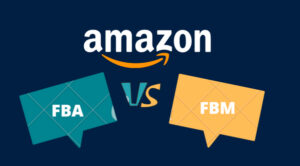Amazon FBA vs Amazon FBM
ℹ️
➠ Statistics intro – Amazon in numbers
➠ Amazon FBA and FBM in a nutshell!
➠ Can FBA and FBM go hand in hand?
➠ The role of Amazon Prime
➠ Advantages and disadvantages of the FBA model
➠ Advantages and disadvantages of the FBM model
➠ Conclusion

Statistics Intro – Amazon in numbers
In this article, we will focus on the two most prominent programs from a seller’s perspective, FBA vs FBM.
Before we deep dive into the comparison of these two models, let’s take a look at some super-interesting Amazon “numbers” to sense how big Amazon actually is:
✘ 206 million people visit Amazon every month (source)
✘ Amazon Marketplace features a mind-blowing number of products – more than 353 million in total. (source)
✘ Amazon has 63% of SME sellers, accounting for around 60% of retail sales (source)
✘ Net sales increased 13% to $143.1 billion in the third quarter, compared with $127.1 billion in the third quarter of 2022. Excluding the $1.4 billion favorable impact from year-over-year changes in foreign exchange rates throughout the quarter, net sales increased 11% compared with the third quarter of 2022. (source)
Without further ado, let’s take a look at our main topic – Fulfillment by Amazon (FBA) vs Fulfillment by Merchant (FBM).

FBA and FBM in a nutshell!
Fulfillment by Amazon (FBA) – is a model in which sellers list their products on Amazon’s marketplace and send them directly to Amazon’s fulfillment centers. After that, Amazon basically takes care of everything – it stores the inventory, ships directly to the customers when the purchase is made, takes care of customer support…
You can think of the fulfillment center as a huge warehouse, with some key differences. The biggest one is that fulfillment centers usually store products for short periods of time before they are shipped out, whereas warehouses store for an extended period of time. More regarding the differences via link here.
Fulfillment by Merchant (FBM) – is a model in which sellers list their products on Amazon’s marketplace, but they do not ship those products to Amazon’s fulfillment centers. Instead, sellers manage all the storage, shipping, and customer support themselves (or through another third party).
In terms of popularity, although the FBA model has higher fees, it is much more present because of its convenience for the majority of sellers. However, the FBM model definitely has some great features. But how to choose between these two? Factors to consider:
✘ Product characteristics (size & weight)
✘ Customer relations
✘ Seller feedback & product reviews
✘ Inventory turnover rate
✘ Logistics activities
✘ Costs/Fees
Product characteristics (size & weight)
The FBA model is recommended for sellers who have a small and lightweight inventory that turnovers quickly. On the other hand, sellers who work with large, oversized, and heavy products that perhaps require specialized packaging should go with the FBM model.
Customer relations
Contrary to the FBA model, FBM sellers are in charge of handling all of the customer services by themselves. Many sellers prefer to have a personal relationship with the customers or have an existing customer support system in place. In that case, the FBM could be the right model for them. Alternatively, if sellers cannot deal properly with the customer service, they should handle the process to Amazon, and choose the FBA model.
Seller feedback & product reviews
Amazon’s seller feedback system was built so that Amazon customers could read the experiences of previous buyers with different sellers. Keep in mind that the seller feedback and the product review are two different things. The product review only relates to the product itself, its quality, usability… Opposingly, the seller feedback has to do with a customer’s satisfaction with the seller, it’s an evaluation of the customer service experience delivered by the merchant.
Seller feedback consists of 2 parts:
– Star rating: where customers can rate their seller’s service on a scale of 1-5 (5 being the best rating)
– Comment section: besides the star rating, customers can leave comments explaining why they gave a certain star rating
FBA sellers have less to worry about customer satisfaction. Why? Simply because Amazon handles the whole process. If an FBA seller receives a negative rating, Amazon can be asked to remove the feedback. On the other hand, FBM sellers handle the whole shipping and communication process thus having a higher chance of getting a negative rating.
Seller feedback and overall customer satisfaction will impact sellers’ performance on the Amazon marketplace. Naturally, Amazon ranks better sellers who are more reliable to their customers.
Inventory turnover rate
Investopedia defines the inventory turnover as a ratio showing how many times a business has sold and replaced inventory during a given period. In other words, how fast you can sell your existing products and order new ones.
For FBA sellers, the turnover rate is one of the most important factors that Amazon takes into account. Amazon tracks the length of time that inventory remains in its fulfillment centers, it does not want to store unnecessary products for months or years. Besides, storing items for a long period at Amazon’s fulfillment centers is equally bad for sellers (no sales + higher fees that Amazon charges).
Consequently, FBM makes more sense for specific types of products that do not have a fast turnover or get sold in small volumes.
Logistics activities
By now, we’ve learned that FBM sellers have to ship items to each customer without using Amazon’s fulfillment centers. They can do that using their own logistics capacities meaning some sellers prefer freedom and autonomy in the overall process, although building a logistics system is usually a large investment. Another option is to engage a 3PL.
Logistics itself requires a lot of time and resources – labeling, picking, packing, organizing, and shipping are time-consuming activities. For many sellers, it is easier to just handle all of it to Amazon so they can turn their focus to other important activities.
Costs/Fees
FBA fee covers the pick, pack, and ship costs from the Amazon fulfillment centers to the end consumer. However, FBA can be a costly program to participate in, with multiple additional fees to cover such as monthly storage fees, long-term storage fees…
FBM sellers do not have to pay as many fees as FBA sellers, but they still have some costs (they pay for the listing on Amazon’s marketplace). In addition, FBM sellers have the cost of maintaining their own logistics network (storage, packaging, shipping), labor hours, and equipment to operate.
If, in the longer run, the abovementioned FBM-related costs are higher in comparison to the Amazon FBA fees for handling the fulfillment, the seller should consider sticking to the Amazon FBA model.

Can FBA and FBM go hand in hand?
It may sound a bit crazy, but yes, a seller can be a part of both FBA and FBM programs.
Sellers who sell different types of products can choose to use both models, adding the benefits and eliminating the drawbacks.
Let’s take a random scenario as an example – a seller of computer equipment. Desktop computers are heavy, bulky, and require specific fragile packaging. On the other hand, computer accessories are also part of a product portfolio (mouse, external keyboard, USB sticks, batteries, headphones…). Those accessories are relatively light, do not require any specific packaging, and have a high turnover rate. To maximize profits and minimize expenses, for customers buying desktop computers, a seller could use the FBM model, while for customers buying computer accessories, the FBA model looks appropriate.

The role of Amazon Prime
Amazon Prime is a subscription service that brings many benefits to its users, the most famous is fast delivery (ranging from hours up to 2 days). Furthermore, Prime members receive benefits such as streaming service, exclusive shopping deals and selection, unlimited reading, and more. Regular Amazon Prime subscription costs $14.99 per month or $139 annually.
Here are some significant statistics when it comes to Amazon Prime:
✘ Over 200 million people have Amazon Prime memberships. (source)
✘ The average Amazon Prime customer spends $1400 yearly, compared to $600 spent by non-member customers. (source)
Both FBA and FBM sellers can ship products via Prime thus reaching the Prime audience. However, for FBM sellers it is not that easy. Amazon, indeed, wants to make sure that those FBM sellers can live up to the high expectations that Prime members have.
Starting from October 1, 2023, significant changes are coming to Seller Fulfilled Prime (SFP) eligibility requirements. If you’re already an SFP seller, you won’t need to undergo the trial again as long as you meet the updated eligibility criteria. These changes are aimed at ensuring the speed and reliability of SFP shipments align with other Prime deliveries.
To achieve the FBM Prime badge, there is a list of requirements sellers need to fulfill in a 30-day trial period, just to name a few: ship more than 99% of their orders on time, let Amazon handle all customer inquiries, have a cancellation rate of less than 0.5%, use ship methods that support weekend delivery and pick up (Saturday or Sunday) and much more! For a full list visit https://www.junglescout.com/blog/seller-fulfilled-prime/
It goes without saying how beneficial but demanding at the same time it is to have SFP badge for a FBM seller. The FBA model seems a better option in this case since FBM sellers have to qualify for this powerful feature which is, alternatively, automatically available to FBA sellers.

Advantages and disadvantages of the FBA model
In this section, we will only focus on the advantages and disadvantages of the Fulfillment by Amazon model. First, let’s take a look at the advantages.
Amazon takes care of the logistics and customer service – this can easily be considered as one of the major benefits of the FBA model. Sellers become a part of the Amazon fulfillment network which handles the shipments quickly and effectively. Outsourcing the logistics part to Amazon can help sellers win more customers and expand their business. Sellers do not have to worry about storage, packaging, shipping, tracking…In addition to managing fulfillment, Amazon provides customer service as well (requests, appeals, or any other problems that may arise in the process)
Automatic Prime eligibility – sellers who are part of the FBA program have their products eligible for Prime shipping. We’ve learned that Prime customers buy more frequently and spend more thus contributing to higher profits. This is a big benefit of the FBA model, which is not automatically available to FBM sellers. .
Buy Box feature – it gives greater visibility to the products thus making the sale more probable to happen. Many factors determine who wins the Buy Box and the fulfillment method is definitely one of them. FBA sellers clearly have an advantage here because Amazon controls the whole fulfillment process which is a guarantee the customers will get the products as quickly as possible.
Better listing rank in the search results – although this is not officially confirmed by Amazon, it is widely believed that choosing the FBA model is one of the major factors that influence Amazon SEO. Sellers with FBA usually have their listings displayed at a higher position in the search results which again means greater chances of making the sale.
More time available to focus on business growth – since sellers can outsource many time-consuming activities to Amazon, they can focus on developing some other parts of their businesses, such as scouting for better suppliers, and higher quality products or investing more time in building marketing campaigns…
Now let’s point to some of the disadvantages of this model.
Product preparation – before the seller sends the inventory to Amazon fulfillment centers, products must be properly labeled, prepared, and packed to make sure the correct one will be shipped to the end customer. If a seller performs the labeling and preparing process incorrectly, Amazon can even reject the incoming shipment and send it back to do the process again.
Higher fees – one of the biggest drawbacks of the FBA model is the number of different fees sellers have to pay. Those fees are affecting the profit in the long run and can eat the margin on most of the products they sell. FBA fees include fulfillment fees, monthly inventory storage fees, closing fees, order handling fees, listing fees, long-term storage fees (in some cases), etc.
No immediate inventory access – sellers have to keep their inventory in the Amazon fulfillment centers, consequently, they have limited access to their products. If there are any problems with the product, sellers have to contact Amazon to resolve the issues. For that reason, many sellers prefer to have 24/7 access to their inventory, especially if some products require customization before the shipment.
Restocking can bring troubles – If sellers do not manage their inventory levels correctly, they can get penalized by Amazon. Sellers who do not predict their inventory turnover punctually will face a lot of challenges (Inventory Performance Index).

Advantages and disadvantages of the FBM model
Now, let’s see the advantages and disadvantages of the Fulfillment by Merchant model. Let’s dive into the advantages first.
Lower Fees / Higher Margins – FBM sellers do not need to pay the fulfillment and storage fees that FBA sellers have to. Bear in mind that having a lower # of fees does not mean having no fees at all – sellers still have to pay Amazon for each product sold on their platform.
Seller controls the whole fulfillment process – for some sellers, this can be seen as a disadvantage, but there are many benefits in handling the inventory before it gets shipped. FBM sellers are able to ensure the quality and punctuality of each order. Furthermore, having more control over the packaging aspect means sellers can provide more personalized packaging compared to the standard Amazon packaging. This can be very significant for some hand-made products.
Less time to launch on Amazon – with the FBM model sellers save time because they do not need to ship the inventory to the Amazon fulfillment centers. Shipping to Amazon is usually a time-consuming process because of the many strict requirements for accepting products and FBM sellers are relieved from these processes, so they can start selling on Amazon much faster than FBA sellers.
Inventory availability 24/7 – since they do not pre-ship anything to Amazon, FBM sellers can access their inventory whenever they need it. Many problems and mistakes can be eliminated this way.
And here are the disadvantages of this model.
Seller handles everything – Sorting, preparing, shipping, tracking, handling the customer service… all of these fall under the FBM seller’s responsibility. As we mentioned earlier, some sellers see this as a benefit, others see it as a drawback. It depends on business size, inventory, turnover, revenue… For many sellers, this is a drawback because it requires that initial investment into the storage facility and sellers have to look for a courier who will deliver the packages to customers.
Less chance of getting the Buy Box – Not having the Buy Box makes it very difficult for sellers to make any traction. The fulfillment method is a crucial factor in determining who gets the Buy Box. Therefore, FBM sellers will have less chance to win it in comparison to the FBA sellers. In this case scenario, FBM sellers usually aim for a lower price in order to win the Buy Box.
No direct access to Prime customers – Unfortunately, FBM sellers are not able to automatically access the Prime customers. They have to apply for the SFP program (which we covered in the upper section). A common complaint that many FBM sellers have is that they lose most of their sales to FBA sellers. This mostly refers to those Prime customers who are far more likely to buy from the FBA sellers than from the FBM ones.
Overhead costs – Although FBM sellers are able to escape some Amazon fees, they are not able to avoid overhead costs (i.e. staff charges, warehouse rent, utilities, inventory tracking, goods manipulation and other related costs). It is crucial to build an analysis that can answer whether, in the long run, these costs will remain lower than the Amazon FBA fees.
Conclusion
To sum up, there is no better or worse when it comes to the FBA vs FBM choice. The purpose of this article is to objectively present the characteristics of the models, not to praise any of the two. As we saw, both FBA and FBM have their advantages and disadvantages. It is up to individual sellers to determine which model works better for them.

